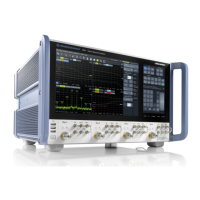Command reference
R&S
®
ZNA
1056User Manual 1178.6462.02 ─ 20
Example: Suppose CALCulate1:TRANsform:DTFault:PEAK:COUNt?
returns 3, then
CALCulate1:TRANsform:DTFault:PEAK:DATA1; DATA2;
DATA3
returns the coordinates of the DtF limit violation peaks.
Options: R&S ZNA-K2
Manual operation: See "Fault Table" on page 768
CALCulate<Chn>:TRANsform:DTFault:PEAK:STATe
<DtfPeakState>
If the active trace of channel <Chn> is a Distance to Fault (DtF) trace, this command
allows to enable/disable DtF limit checking.
Suffix:
<Chn>
.
Channel number used to identify the active trace
Parameters:
<DtfPeakState> OFF|ON (0|1)
Example:
*RST; :CALCulate1:TRANsform:DTFault:STATe ON
makes the active trace of channel 1 a DtF trace.
CALCulate1:TRANsform:DTFault:PEAK:STATe ON
enables DtF limit checking.
Options: R&S ZNA-K2
Manual operation: See "Fault Limit Check" on page 765
CALCulate<Chn>:TRANsform:DTFault:PEAK:THReshold <PeakThreshold>
If the active trace of channel <Chn> is a Distance to Fault (DtF) trace, this command
allows to set the fault limit for DtF limit checking.
Use CALCulate<Chn>:TRANsform:DTFault:PEAK:STATe to enable DtF limit
checking.
Suffix:
<Chn>
.
Channel number used to identify the active trace
Parameters:
<PeakThreshold> Fault limit
*RST: -20 dB
Default unit: dB
Example:
*RST; :CALCulate1:TRANsform:DTFault:STATe ON
makes the active trace of channel 1 a DtF trace.
CALCulate1:TRANsform:DTFault:PEAK:THReshold -30
sets the DtF limit to -30 dB.
Options: R&S ZNA-K2
Manual operation: See "Fault Limit" on page 765
SCPI command reference

